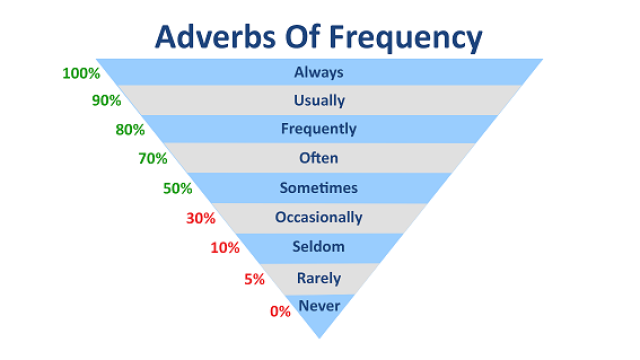Frequency adverbs are words that describe how often an action occurs. They are used to express the regularity of an activity or event.
Frequency adverbs can range from actions that happen all the time to those that happen rarely or never.

Common Frequency Adverbs:
- Always (100% of the time)
- Example: She always wakes up early.
- Usually (about 90% of the time)
- Example: He usually walks to work.
- Often (about 70% of the time)
- Example: They often go to the park on weekends.
- Sometimes (about 50% of the time)
- Example: We sometimes eat out for dinner.
- Occasionally (about 30% of the time)
- Example: She occasionally visits her grandparents.
- Rarely (about 10% of the time)
- Example: He rarely gets sick.
- Seldom (about 10% of the time, similar to “rarely”)
- Example: They seldom watch TV.
- Never (0% of the time)
- Example: I never drink coffee.
Position in a Sentence:
- Frequency adverbs usually come before the main verb in a sentence:
- She always drinks tea in the morning.
- If the verb is a form of “to be,” the adverb comes after the verb:
- He is usually late to class.
- In questions, frequency adverbs usually come after the subject:
- Do you often go to the gym?
Usage Tips:
- Frequency adverbs help to give more precise information about how often something happens, making your sentences clearer and more detailed.
Understanding and correctly using frequency adverbs can greatly improve both spoken and written English.
Learning Activities:
Activity #1: “Adverb Charades” Divide the class into small groups. Each group acts out a scenario together using a chosen adverb of frequency, while the other groups try to guess both the activity and the adverb. This activity encourages creativity, collaboration, and active learning, making it a fun and effective way for high school students to practice and internalize adverbs of frequency.
Activity #2: “Frequency Survey” Create a survey for your peer. It must have 10 questions and the answer must include the usage of an adverb of frenquency. Example of the questions:
How often do you do your homework?
How often do you eat breakfast?
How often do you watch TV?
How often do you play sports?
How often do you check social media?
